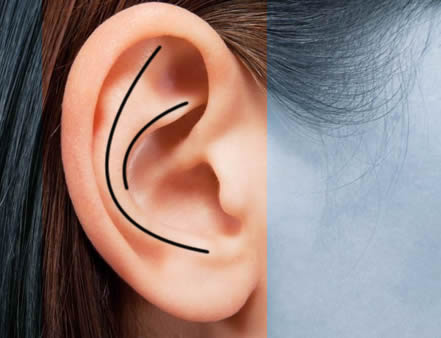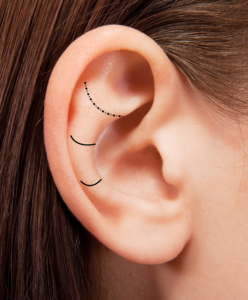Ear Aesthetic Otoplasty

Otoplasty The most common ear malformations are protruding ears. Distended ears often cause physicologic problems, as these deformities can cause feelings of shame and inferiority in children, but also in adults. The malposition is usually due to a congenital deformation of the ear cartilage or by an asymmetric development of individual cartilage parts. With surgery, the ear cartilage can be reshaped and the ear is put on. This procedure can be performed at any age. Since admission to school is a significant event for the children, for psychological reasons, surgical ear correction should at best be done before school entry, but no later than 10 years of age. Since in the protruding ears usually the plicated part of auricle, the so-called Anthelix, either too weak or even completely absent, the ear cartilage must be reshaped and fixed in this new form in the ear correction. Occasionally it is a combined malformation involving other parts of the ear. The auricular cartilage is exposed in our preferred technique from a largely occluded cut within the pinna edge and thinned with a fine diamond grinding head until the cartilage is placed in the desired shape and then fixed with three to four fine U-sutures. Then the skin is closed with a continuous suture. If only with this technique the ear shape can not be sufficiently corrected. ear aesthetic
You might consider otoplasty if
Anesthesia and hospital stay
The surgery can be performed in adults and school children under local anesthesia. However, if you prefer a general anesthetic for yourself or your child, you must have the appropriate anesthesia check-up the day before at the hospital. In a preliminary talk, the anesthetist will give you all the necessary explanations. Children and adults who undergo local anesthesia visit the clinic on the day of the ear correction and can leave the clinic the day after the operation. If there are no complications in the ear correction, the procedure can also be performed on an outpatient basis.
How do I prepare for the operation?
You do not have to specifically prepare for the ear correction. However, it is good if you get a wide, soft headband, which you can then wear over your ears after surgery. In addition, you should not take painkillers containing acetylsalicylic acid ten days before the ear correction because they may delay blood clotting, causing rebleeding with damage to cartilage and skin.
How is the operation going?
The patient lies with the ear correction in supine position with slightly raised head. After cleansing and disinfecting the face and the hairline, the hair and the rest of the body are covered to the neck with sterile towels. Local anesthesia requires a small, hardly painful puncture behind the earlobe. In addition, the skin in the auricle is anesthetized. The skin incision and the sutures are not felt. After forming the ear cartilage and fixation with permanent transparent sutures, the skin wound is closed with a continuously sewn suture. In both ears protruding ears, the ear correction is completed first on one side, then on the other side. The procedure takes about an hour. Following the operation, both ears are fixed with plaster reins on which a cap bandage comes. Adults can wear a wide headband.
What happens after the operation?
Immediately after the ear correction, slight pain and possibly a bluish discoloration is to be expected. Both are formed within a few days. When sleeping and lying down you should wear a cap bandage or a soft headband for the first three weeks, so that there is no kinking of the auricle. In addition, the ears are still swollen and touch-sensitive. The patches and the dermal thread on the ear are removed about ten days after the ear correction at re-presentation in practice. The final ear shape is reached because of the remaining residual swelling after two to three months. The scar fades over time and is barely recognizable later. If the procedure is to be performed on an outpatient basis, it must be taken into account that the reactivity is temporarily impaired following the application of a sedative, analgesic or anesthetic. Therefore, let yourself or your child be picked up and ensure constant supervision in the first 24 hours.

What risks are to be considered in the case of an ear correction?
If you suffer from allergies (eg to medicines), if you have other known illnesses or if you take medication on a regular basis, you must notify us of this. If you have noticeable bruises or if you have experienced persistent bleeding after minor injuries, a coagulation disturbance prior to surgery should definitely be ruled out by a special examination.

What complications can arise?
Despite the utmost care, occasional complications may occur during or after an ear correction. If you have severe pain after surgery, this may indicate a too tight bandage or a bruise. This must then be controlled by the doctor. A bruise can be punctured in most cases and requires only in exceptional cases, a repeated operation. A temporary disturbance of the touch after the ear correction is normal and disappears after some time by itself. Very rarely, with appropriate disposition in the scar (keloid), which is characterized by a thick, bulging, discolored, painful and itchy scar represents. Cortisone injections, pressure bandages and a subsequent surgical removal, In rare cases infection of the wound or the ear cartilage may occur, causing a delay in healing. Very rare is the damage of skin or cartilage due to disruption of the blood supply. The risk is increased if previous procedures on the outer ear have already been performed. Most of these places heal spontaneously. Operative defect coverage is rarely required. All surgical procedures require the transection of fine skin nerves, which can lead to emotional loss or discomfort, especially in cold weather. This slowly recedes over several months, but can be persistent in individual cases. In the rare incompatibility of the thread material, it comes to the repulsion of the thread and thus to a renewed standing of the auricle edge. The cosmetic results after an ear correction are usually good. No ear is the same, neither before nor after the operation. One ear be larger than the other and continue to stand. The cartilaginous skeleton can also be constructed differently than the other one. Even after the procedure, the result may change due to scarring or due to the restoring forces of the cartilage, so that again a deformation of the auricle can occur. In a second surgical intervention, the results can be corrected again in such cases.
Which after treatment is required?
Up to three weeks after the operation you should wear a cap bandage or a headband when sleeping and lying down. The sutures are removed together with the plaster bandage one week after the ear correction.
What should be considered after the procedure?
Inability to work and school incapacity is expected for three to four days. Sport should be avoided for about six weeks. When washing your hair, you should be careful and do not bend your ears for six weeks.
Free Consultation

